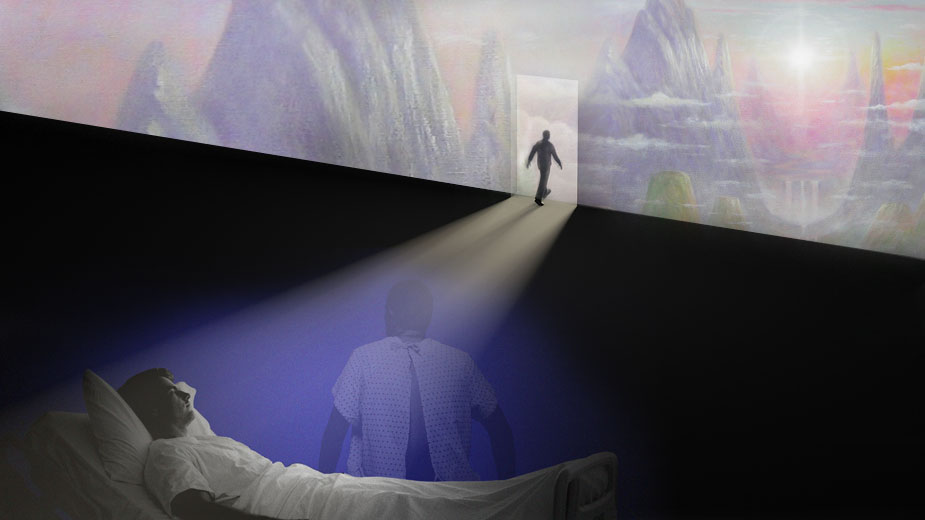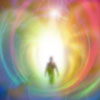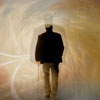The Self Does Not Die
 by Rudolf H. Smit, Titus Rivas, Anny Dirven
by Rudolf H. Smit, Titus Rivas, Anny Dirven
From the perspective of parapsychology, or psychic research, one feature is probably most responsible for near-death experiences (NDEs) coming to public attention as a phenomenon with possible paranormal aspects: specific impressions of the material world that near-death experiencers (NDErs) reportedly perceived from a location outside their physical bodies.
Many stories have been published about NDEs in which experiencers had the feeling that they left their bodies and perceived the material world from a location apart from their bodies. During this out-of-body (OB) aspect of the NDE, the NDEr typically perceived his or her own body as well as what was happening in the surroundings in which that body lay and sometimes physical locations away from the body, apparently without using the physical senses—the very definition of extrasensory perception. Later, it turned out that what the experiencer saw and heard during the OB aspect corresponded exactly with the determinable facts, meaning that the perceptions were verified as accurate, or veridical. Within the professional literature about NDEs, these perceptions are usually considered to be a subcategory of “AVPs”–that is, apparently nonphysical veridical perceptions, a term coined by Jan Holden (2009). The verification can range from weak (verified by the experiencer alone) to strong (verified by a researcher in the course of a study), but the accuracy is verified nonetheless. These types of experiences are probably what most people think of regarding the subject of “paranormal experiences during an NDE.”
In some cases, the veridical perception of the physical environment appears to have taken place at a point in time when most mainstream neuroscientists would consider the experiencer to have insufficient brain activity for complex, conscious perception to occur. This category of experience contradicts the prevailing scientific theory that all forms of consciousness are entirely dependent on a functioning brain and, specifically, that complex forms of human consciousness are dependent on an active neocortex.
In the following cases of medical patients’ NDEs we cannot be certain or sufficiently certain of the exact moment of the purported extrasensory perception. In other words, it is conceivable that the NDE did not coincide with clinical death. Of course, this condition does not mean that paranormal perception necessarily occurred before the patient’s brain stopped functioning or after it became sufficiently active again; it simply means that the extent to which the patient’s brain was functioning at the time of the veridical perception cannot be determined. Furthermore, although OBEs and NDEs do not depend on a flat-lined electroencephalogram (EEG) in order to occur, a flat-lined EEG may stimulate the occurrence of an OBE because the flat-line condition may lead to a temporary loosening of the psyche, mind, soul, or consciousness from the earthly body.
We furthermore make a distinction among (a) cases that were reported by someone other than the NDEr; (b) cases in which the perceptions were confirmed, but only by means of a medical report or file; and (c) cases in which investigators have a statement both from the patient and from one or more witnesses. The probative value of the last category is obviously the greatest, particularly if the witness’s/witnesses’ statement(s) were made independently of the patient’s statement. Cases that have only a doctor’s or nurse’s statement are also more probative than cases in which only the patient claims to have had paranormal perceptions.
The following cases address the paranormal aspects of NDEs. This focus means that we will leave other stages, aspects, or elements of individual NDEs out of this review which may leave unaddressed some of the broader spiritual meanings of the experiences.
CASE 1.1 Emine Fougner’s Father
Emine Fougner, a translator and computer scientist of Turkish descent from Arizona, sent Titus Rivas [co-author of book from which this article is excerpted] an email at the end of 2006. From further correspondence in March 2007, she learned some details about the medical condition of her 58-year-old father from Hamilton, Canada. This man ended up in a Canadian hospital for various interventional operations and tests, including undergoing a complicated form of vascular surgery in connection with a fistula. Afterward, Fougner’s father told her what he had experienced during his surgery. Fougner emphasized that, in order to spare her father unnecessary distress, it had been decided not to tell him too many details about his impending surgery, so her father was not aware of the various procedures that the doctors and nurses would be performing during the operation. Emine Fougner emailed her entire personal contact list a message that we summarize as follows:
But after the operation (two days after, to be exact, because he had received heavy anesthesia), he described one by one all the procedures that were performed during the operation the way someone who is observing would do. But how was that possible? He was fully anesthetized and was attached to machines on both sides. We know that he experienced an OBE. He said that he knew that he had died at a certain point. He felt his lower jaw grow cold and he couldn’t feel the rest of his body; he could only see his chin through which, he said, a shiver passed. He also told us that he could see a group of people who looked like they were soldiers who were coming to get him. He could hear them and one of them said to the others, “We won’t be taking him.” What that, his body and soul were united again.
Fougner noted that her father’s perceptions truly corresponded with what she heard from the medical staff about the operation. In a later email, Fougner added that her father would never believe in things like that if he had not personally experienced them. He was a changed person after the operation.
CASE 1.2 Joan La Rovere’s Young Patient
Sam Parnia is a physician affiliated with various hospitals in the United Kingdom as well as the Weill Cornell Medical Center in New York City. In his book What Happens When We Die, Dr. Parnia reported the case of a U.S. Doctor by the name of Joan La Rovere, whom he met personally. Dr. La Rovere told him the following story, which we summarize.
At the time of the case, La Rovere was in England working as a member of a team that went to small local hospitals to pick up sick children who had to undergo treatment by specialists at the Great Ormond Street Hospital in London. One evening she went with the rest of her team to a hospital in Kent, some 20 miles from London, to pick up a 9-year-old girl with a serious kidney disorder. The child was very ill and had to be rushed to the Great Ormond Street Hospital to be treated in its pediatric intensive care unit.
During the ambulance ride, the team got stuck in rush-hour traffic. They were driving as fast as they could, with lights flashing and sirens blaring, but were not making enough headway, so the girl’s condition worsened quickly. Suddenly the girl’s heart gave out, and she suffered cardiac arrest. La Rovere’s team immediately began resuscitation in the ambulance, but despite repeated attempts throughout the long traffic delay, they could not get her heart going again.
Finally, one of the nurses remarked that the girl was dead. She suggested leaving the highway and driving to a local hospital to have a coroner’s report drawn up.
La Rovere, however, had an intuitive feeling that they had to continue resuscitation, even though it looked as if they had really lost her. She said, “If she’s going to be pronounced dead, it will be at Great Ormond Street and nowhere else.” So they continued resuscitation. Although La Rovere had little hope that it would succeed, something inside told her that she needed to talk to the girl during the resuscitation. She kept reassuring the girl and told her that she should not worry and that everything would be all right.
At about the time that they arrived at Great Ormond Street Hospital, the girl’s heart started up again, although she was still in very critical and unstable condition. La Rovere’s duties at that time were limited to picking up patients from other hospitals. She did hear from Great Ormond Street Hospital nurses, though, that the girl gradually got better and could finally be discharged from the hospital.
Parnia cited La Rovere with respect to what happened a few months later when the girl visited the hospital to meet everyone who had cared for her:
During her visit, she asked one of the nurses, “Where is the American doctor who looked after me in the ambulance and who was talking to me during the trip?” She had watched everything from above and had recalled all the details. I was amazed when I heard this, as she’d never even seen me throughout the trip. She had been too ill and had been on a life-support machine.
The following comes from an article “The Nature and Meaning of the Near-Death Experience for Patients and Critical Care Nurses,” by U.S. Investigators and PhD-level nurses Linda L. Morris and Kathleen A. Knafl, which highlights descriptions of nurses’ experiences.
One of these concerned a female nurse who witnessed how a patient recognized her. She was giving the patient, a woman, a bath, when the patient remarked, “You were here yesterday.” The nurse asked her what she remembered. The patient told her that she had seen from above how the team had tried to resuscitate her. She also remembered a conversation between the nurse and one of the doctors about the dress code. The doctor had, in fact, said to the nurse that she was not allowed to wear dresses to work anymore in response to the fact that she had worn a skirt that day.
CASE 1.4 A Heart Shaped Like Africa
A case from the book Recollections of Death by U.S. Cardiologist Michael B. Sabom concerns a 52-year-old night watchman from North Florida who experienced two heart attacks with cardiac arrest in 1973 and 1975. Dr. Sabom met him for the first time in November 1977 and learned that the patient had had an extensive NDE during his first cardiac arrest in December 1973. In January 1978, this patient had to undergo open-heart surgery at the University of Florida’s medical center. At their next meeting, the patient turned out to have had an NDE during his second surgery as well. During this operation, the patient found himself suddenly above his body. He observed his own body, various medical procedures, and the instruments used. He also caught snippets of conversation that went on during the operation.
The observations did not completely meet the patient’s expectations. He was surprised to have seen that his heart was shaped somewhat like the continent of Africa, and there was less blood loss than he had expected. He also saw, for example, that one of the doctors involved was wearing white shoes and was the only one not wearing green scrub covers over those shoes.
Sabom compared the patient’s observations with the medical report of the operation. The cardiologist concluded that many specific details in the report corresponded exactly with the patient’s description, including the following consistencies:
1. The patient said, “My head was covered, and the rest of my body was draped with more than one sheet, separate sheets laid in layers.” The medical report: “[The body was] draped in the customary sterile fashion.”
2. Patient: “I could draw you a picture of the saw they used.” Medical report: “The sternum was sawed open in the mid-line.”
3. Patient: “The thing they used to separate the ribs with. It was always there. . . . It was draped all around you, but you could see the metal part of it. . . . That thing they held my chest open with, that’s real good steel with no rust, I mean, no discoloration. Real good, hard, shiny metal.” Medical report: “A self-retaining retractor was utilized over wound towels.”
4. Patient: “One general area to the right or left was darker than the rest instead of all being the same color.” Medical report: “The ventricular aneurysm was dissected free. . . . The aneurysm was seen to be very large.”
5. Patient: “He cut pieces of my heart off. He raised it and twisted it this way and that way and took quite a bit of time examining it and looking at different things.” Medical report: “An incision was made over the most prominent portion of the aneurysm after the heart had been turned upside down in the pericardial wall. . . . The entire aneurysm was resected.”
6. Patient: “Injected something into my heart. That’s scary when you see that thing go right into your heart.” Medical report: “Air was evacuated from the left ventricle with a needle and syringe.”
7. Patient: “They took some stitches inside me first before they did the outside.” The medical report states: “The wound was closed in layers. . . . The pectoral fascia was reapproximated with interrupted sutures of 2-0 Tevdek . . .subcutaneous tissue was closed with a running suture of 3-0 chromic . . . the skin was closed with 4-0 nylon.”
Sabom commented that some details that the patient reported did not appear in the medical report because they concerned aspects that were not essential in an operative summary. According to Sabom, however, these details, too, were accurate in the context of an open-heart operation.
CASE 1.5 A Surgeon Taking Flight?
In New England, van driver Al Sullivan underwent an emergency operation at age 56 at the Hartford Hospital in Connecticut. He was having heart arrhythmia at work, and when he was examined at the hospital, one of his coronary arteries became blocked, requiring him to undergo immediate surgery. During the operation, he felt himself leaving his body. He had the feeling of rising up and, in doing so, seemed completely surrounded by a kind of thick, black smoke, until he finally rose to a kind of amphitheater that he was unable to enter. There was a wall between him and the theater, and behind it a particularly bright light was shining. He managed to hold on to the wall and to look over it. To his surprise, he saw his body in the lower left, lying on a table and covered by light-blue sheets. He also saw how he had been cut open to expose his chest cavity. He saw his heart and also his surgeon, who had explained to him prior to the operation what he was going to do. This surgeon looked a little perplexed. It even seemed like he was “flapping” his arms as if trying to fly.
Then Sullivan moved beyond the material, physical realm in what is called the transmaterial aspect of his NDE, in which he saw deceased loved ones (among them his mother, who had died young) and a glorious, yellow light, all the while experiencing overwhelming feelings of warmth, joy, love, and peace.
Finally, Sullivan was resuscitated. As soon as he was able to speak again, he shared the experiences he had had during the operation with his cardiologist, Anthony LaSala. The latter attempted to ascribe the experiences to the medication, however. It was only when Sullivan described how the heart surgeon, Hiroyoshi Takata, had flapped his elbows as if he were trying to fly that Dr. LaSala’s attitude changed. He wondered who could have told Sullivan about this, considering it was in fact a personal habit of Takata’s. When Dr. Takata was not operating, he wanted to avoid contaminating his hands, so he would lay his palms flat on his chest and direct his assistants by pointing with his elbows.
According to Sullivan, LaSala told Takata when Sullivan had observed this during the NDE, but Takata, rather than focusing on this perceptual anomaly, took the information as personal criticism of the quality of his surgical care of Sullivan. Takata said, “Well, you’re here, you’re alive, so I must do something right!” His defensive response raises the question of how many veridical accounts may have been overlooked or hidden as a result of surgeons’ concerns about professional competency or legal liability.
In the fall of 1997, investigator and psychiatrist Bruce Greyson interviewed both LaSala and Takata. Takata could not specifically confirm that he had “flapped” his elbows during the operation on Mr. Sullivan, but he did acknowledge that this was a general habit with him. The habit stemmed from the desire not to touch anything with his sterile hands as he carried out an operation.
LaSala confirmed that Sullivan had spoken with him shortly after the operation about his NDE. He also confirmed that Takata does have the strange habit of “flapping” his elbows, adding that he never saw any other surgeons do anything like that.
In a video reenactment of this case, Sullivan’s eyes were taped shut, and there was a sterile drape over his head that blocked any possible physical perception of Takata. These conditions were explicitly confirmed by LaSala who said, “Even if he was conscious, it would be impossible for Al to see Dr. Takata’s stance or arm movement because Al is behind a drape that blocks the vision of the patient and his eyes were taped shut.” Assuming that pointing with one’s elbows does not produce sounds discernible in the bustle and equipment-related noise of an operating room, Sullivan’s perception could not be attributed to hearing.
CASE 1.6 The Patient From Missouri
Among the cases Michael Sabom included in his book Recollections of Death is that of a 42-year-old woman from Missouri. The patient told him that in September 1972, she had undergone a lumbar-disk operation that she had watched in an out-of-body state from the operating room ceiling.
She saw that the operation was taking place in a green room, and it struck her that the operating table was not next to the medical-instrument table but stood at an angle in the room. The patient subsequently also observed how the medical team operated on her and what roles the two doctors played. After her back operation, she apparently went into cardiac arrest, and they sutured the wound so quickly that it was not done very neatly.
After she had regained consciousness, the patient recognized one of the surgeons involved, even though she had never met the doctor in question prior to the operation. She also shared her NDE with a student nurse who confirmed to her the accuracy of her impressions.
Dr. Sabom consulted the medical report and in this way determined that the operation had indeed been performed by the two doctors whom the patient had observed during her NDE. He also ascertained that there were no discrepancies between the observations the patient reported having had during her NDE and the surgical procedures described in the report. In addition, the operation went differently than the patient had expected beforehand. She had thought that her primary doctor would would perform most of the surgery, but it was the other doctor—whom she had never met—who did the great majority of the work.
Sabom, moreover, had a conversation with the student nurse six years later after the operation. Although she had forgotten many of the details in the intervening time, her story corresponded at least in large part with the patient’s story.
This case dates from the end of the 19th century and was written up by Frederic William Henry Myers in his book Human Personality and Its Survival of Bodily Death.
In 1889, A. S. Wiltse, a doctor from Skiddy, Kansas, suffered from typhoid fever. He finally succumbed and fell into a coma. When the attending physician, S. H. Raynes, could not detect any pulse or heartbeat for four hours, Wiltse appeared to be clinically dead.
As the presence of his case here would indicate, Wiltse nevertheless returned to consciousness. He recounted that he had seen with great interest how his body separated from his spirit. He had felt like a jellyfish as far as shape and color were concerned. His mind loosened from his body like a soap bubble loosens itself from the end of a tube. In that shape, he softly fell to the ground. However, he stood up as a complete but transparent figure, and he noticed that he walked straight through people. He described in detail “with the interest of a doctor” all that he experienced in his out-of-body state.
The following aspects of his experience are important to our purpose in presenting this case. He saw his body lying on a sofa. Two women, kneeling to his left, were crying. After he had regained consciousness, it turned out that the two women had been his own wife and sister—but during the NDE itself, he had not recognized them. Although during his NDE Wiltse had repeatedly tried to let all those in the room know he was as alive as ever, all his attempts failed.
After it was all over, Wiltse described his extrasensory perceptions of the room and his body’s condition during the NDE. He asked witnesses to describe in their own words to what extent his perceptions had been correct. Wiltse sent witness statements—signed in the presence of a notary—to the investigator Richard Hodgson.
The details that Wiltse had observed regarding the room, the people who were there, and the way in which his body had lain either were confirmed by witnesses or were at least not denied by them. Myers included witnesses’ written statements in his book.
Excerpt from The Self Does Not Die: Verified Paranormal Phenomena From Near-Death Experiences
Posted in Life After Death, Near Death Experience, Other Topicswith comments disabled.





